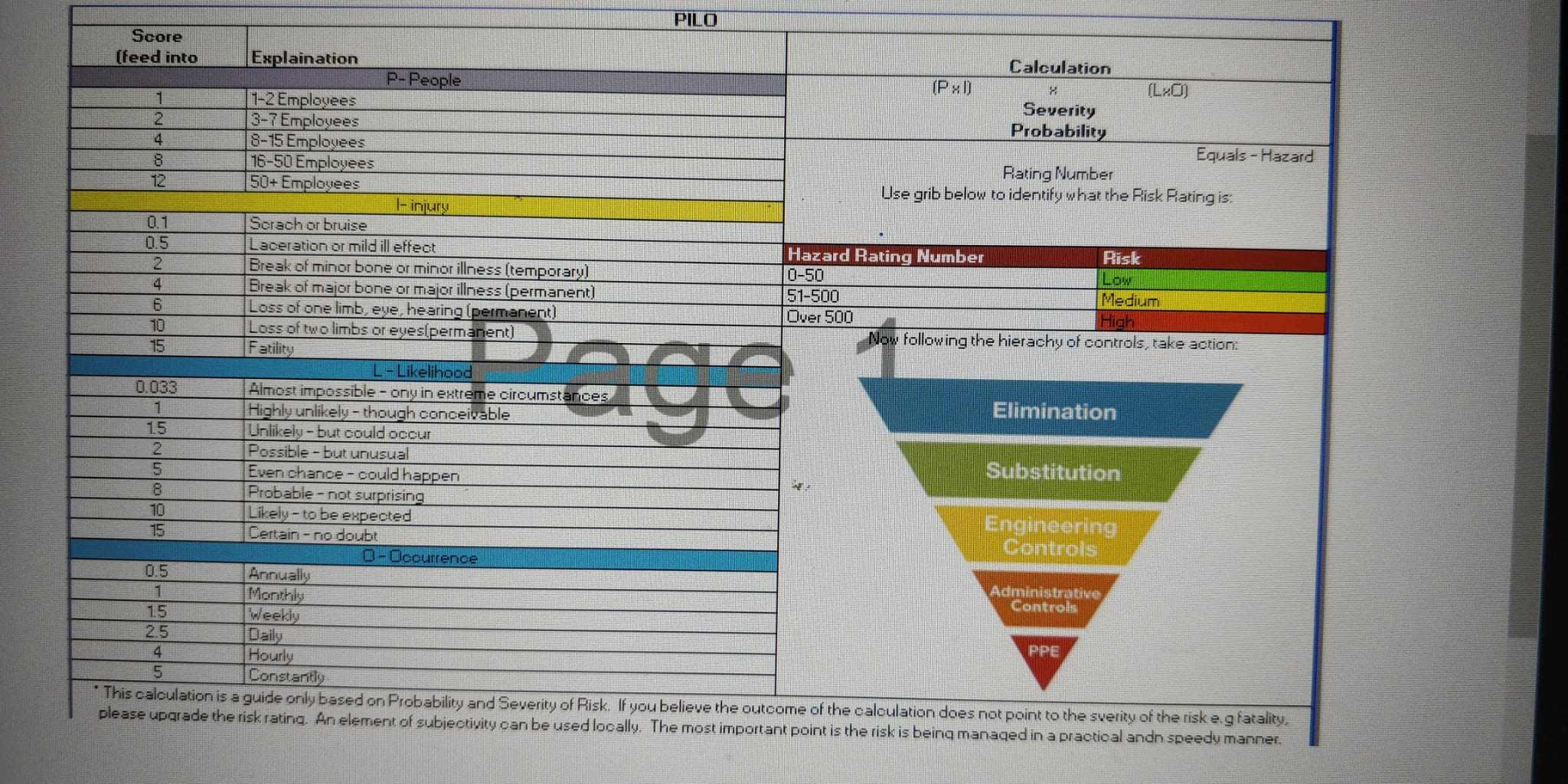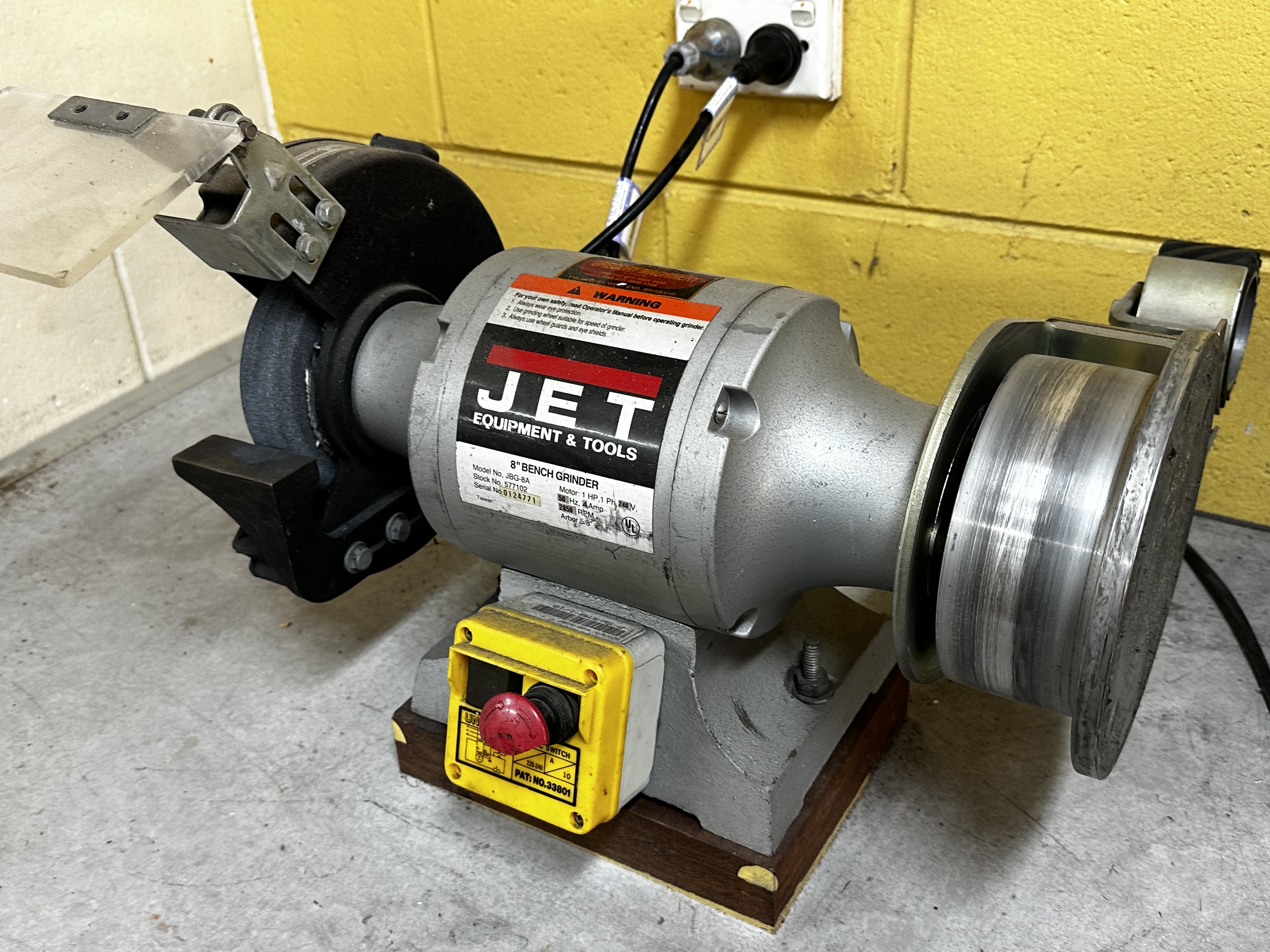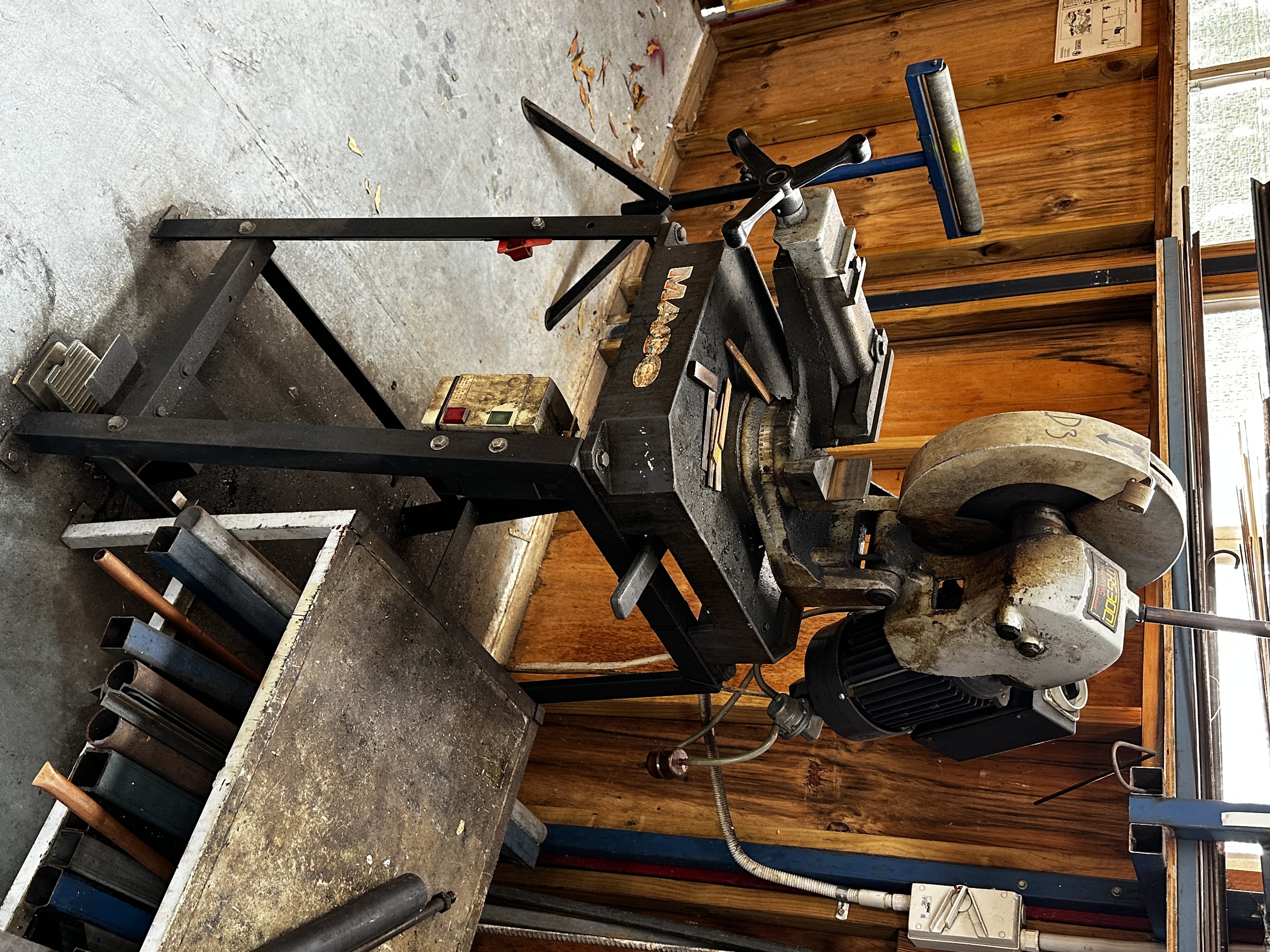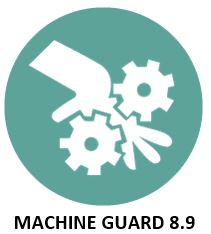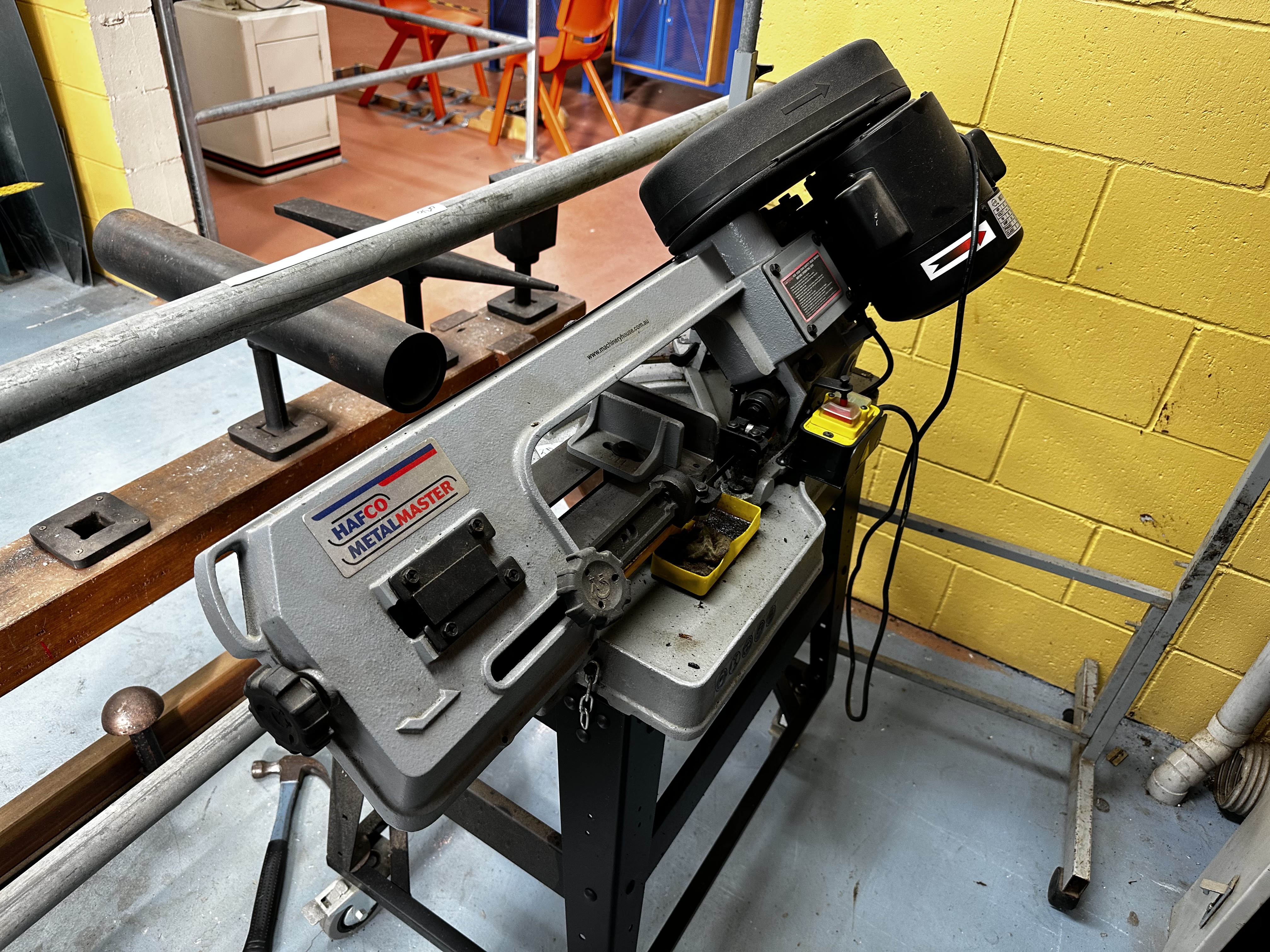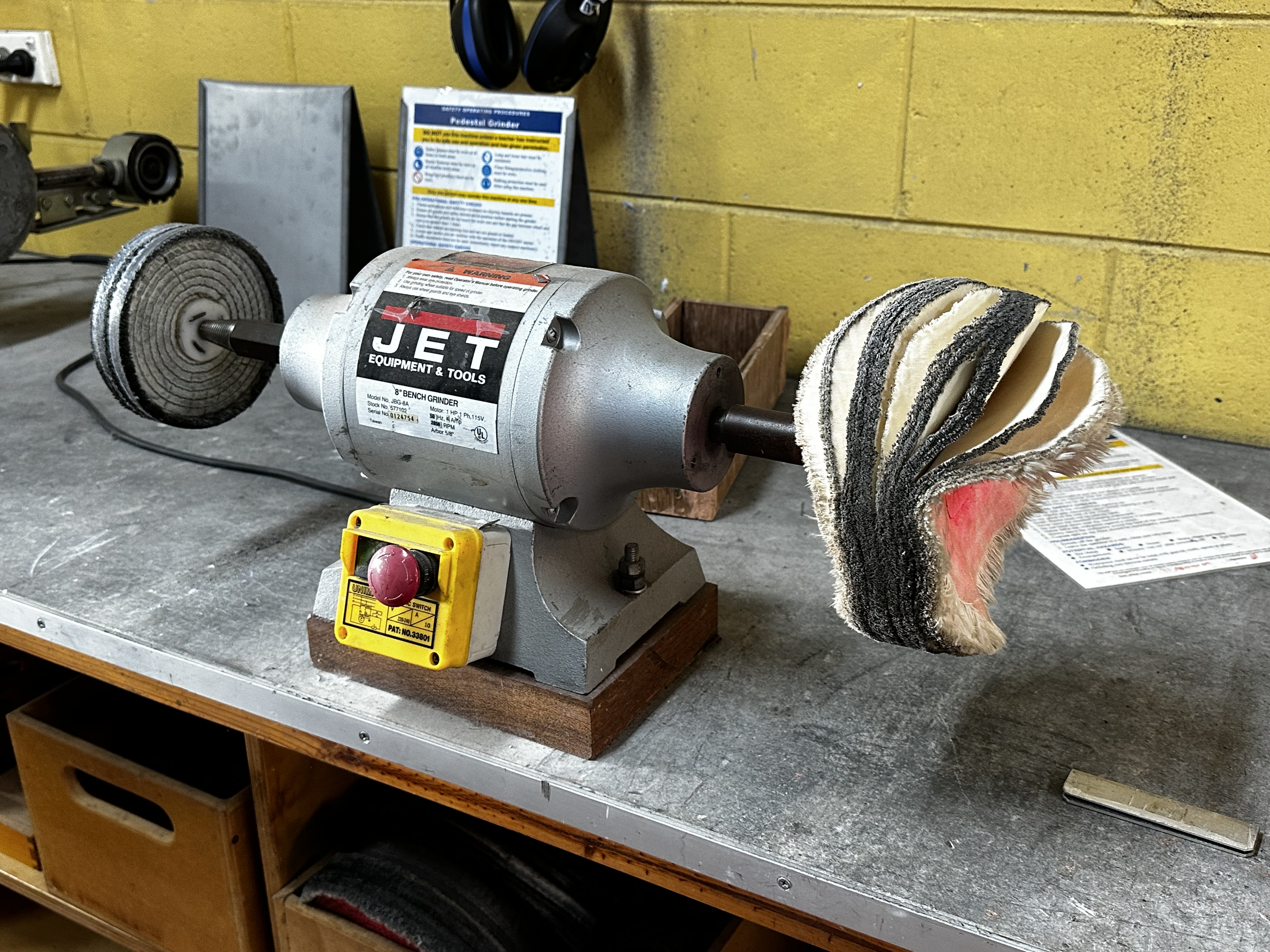Title Page
-
Site conducted
-
Conducted on
-
Prepared by
-
Location
-
Equipment Unique ID
-
Equipment Name
PILO RISK RATING ROOL
Information, Instructions and Safe Use
-
Are there written instructions covering any unusual hazards or complicated features?
-
Are there written instructions covering where appropriate, emergency shutdown?
-
Has instruction, in readily comprehensible form (written or verbal) on <br>all hazards, been passed onto all those who use the equipment?
-
Have any written instructions provided by the manufacturer been passed to users?
-
Have all users of the equipment been given adequate training<br>in correct use, risks and precautions?
-
Is a training record kept which verifies this?
-
If it has been adapted, is the adaptation suitable and safe?
-
Is the equipment being used in accordance with the manufacturer's <br>instructions?
-
Is the equipment used in an appropriate environment? <br>(consider e.g. ventilation, damp, flammable conditions)<br>
-
If the equipment may be moved, is the weight known?
-
Are the start and stop controls clearly marked?
-
Are other operating controls, and the contents of any <br>containers, clearly marked?
-
Are there clear warning notices or markings (e.g. to wear <br>personal protection, restriction on use, list of authorised users)
Maintenance
-
Electrical safety inspection intervals
-
Safety devices inspection intervals
-
Are there records to indicate the above has been complied with?
-
Is there a system of planned preventive maintenance, including, where appropriate, the periodic replacement or refurbishing of items before they reach the end of their useful life?
-
Have clear maintenance instructions been given to those <br>responsible for maintaining the equipment?
Specific Hazards
-
Is protection adequate in relation to items falling from the equipment?
-
Items being ejected?
-
Overturning?
-
Collapse?
-
Overheating or fire?
-
Disintegration?
-
Is the equipment made stable where appropriate by bolting, clamping <br>or tying?<br>
-
Is there sufficient general and, where necessary, local lighting?
-
Is there protection against contact with hot or very cold temperature, so far as appropriate?
-
If the possibility of such contact is unavoidable has appropriate <br>instruction and training been given? <br>
-
In the case of pressurised equipment, is there a written scheme of <br>examination?<br>
-
Whenever a baler or compactor is being unjammed, maintained, or repaired, it should be de-energized. In addition, pursuant to Occupational Safety and Health Administration (OSHA) rules on lockout and tagout, the controls should be locked to prevent the machine from being turned on again inadvertently, and should be tagged to inform other employees that the machine is temporarily out of operation. Is a tagging / lockout system in place?
-
Balers and compactors should be equipped with machine guards and with safety interlocks that will immediately stop the machine if an employee attempts to gain access to the ram or the ram area. Are machine guards with safety interlocks in place?
-
Balers: Employers should establish and follow standard procedures for dealing safely with jams and other disruptions, and for requiring machine operators to account for the presence of co-workers before activating the equipment. Is a documented procedure / Safe System of Work in place?
-
Balers: Employers should train their employees to recognize the hazards of working near balers and compactors, and to be familiar with safe working procedures. Is there documented training records for those operating the baler / shears?
-
Balers: Are all those who operate the baler / shears over the age of 18? Employers should not assign employees under age 18 to service, load, operate, or help operate balers and compactors, except for one limited exemption allowed by law as long as certain safety requirements are followed. The exemption under labour laws allow workers aged 16 and 17 to load de-energized scrap paper balers and cardboard box compactors, as long as the equipment is turned off, the switch is locked in the “off” position, and the employer posts a notice that the machine meets given design requirements. Where this exemption is allowed, the employer should ensure that these safety requirements under the exemption are met, IOSH recommended.
-
Baler: Is the emergency shut off button tested regularly?
-
Do entanglement hazards exist which could cause or contribute to severe injuries or death?
-
Friction and Abrasion - Do Friction and Abrasion hazards exist which could cause or contribute to severe injuries or death?
-
Cutting or Severing - Do Cutting or Severing hazards exist which could cause or contribute to severe injuries or death?
-
Do Shearing hazards exist which could cause or contribute to severe injuries or death?
-
Stabbing or Puncturing - Do stabbing or Puncturing hazards exist which could cause or contribute to severe injuries or death?
-
Do Impact hazards exist which could cause or contribute to severe injuries or death?
-
Pressurized Liquids/Gases Injection/Ejection - Do pressured Liquids/Gases Injection/Ejection hazards exist which could cause or contribute to severe injuries or death?
-
Slipping, Tripping and Falling - Do slip, trip and fall hazards exist which could cause or contribute to severe injuries or death?
-
Electrical Hazards - Do electrical hazards exist which could cause or contribute to severe injuries or death?
-
Hazards Generated by Noise - Do hazards generated by noise exist which could cause or contribute to severe injuries or death?
-
Vibration - Do hazards generated by vibration exist which could cause or contribute to severe injuries or death?
Dangerous Parts of machinery
-
<br>Are all dangerous parts of the machinery guarded?<br>
-
Are all guards of good construction, adequate strength and well <br>maintained?<br>
-
Do guards permit an adequate view of the operation where this is <br>necessary?
-
Is it difficult to bypass or disable guards?
-
Can the machinery only be started when a specific labelled start device <br>is used? (N.B. the normal cycle of automated machinery is exempt from<br>this requirement) <br>
-
Is it impossible to start the machine just by resetting a safety device?
-
Is there a readily accessible stop device which stops the machinery in a <br>safe way? <br>
-
Where appropriate is there a prominent easily accessible emergency stop<br>device?<br>
-
Can controls be operated safely and easily?
-
Is there any system of work which ensures that nobody is in a dangerous <br>position when machinery is about to be started?<br>
Does the start device need to be activated to restart the machine if:
-
the power fails?
-
a control or safety device fails to trip out?
-
If the power is isolated does the machinery come to rest safely <br>without the possibility of access to dangerous parts? <br>
Can the equipment be securely isolated from power, to prevent inadvertent reconnection:
-
by removing a plug from a socket which is easily visible to the person at <br>risk? <br>
-
by locking it off?
Risk
-
Who is at risk?
Hazards Identified
-
"Lack of awareness.
-
Lack of Staff training.
-
Lack of resources.
-
Lack of proactive routines.
-
Lack of safe working practices.
-
No evidence of operators manuals available
-
Unauthorised personnel gaining access to work equipment
-
"No evidence of safe systems of work in place
-
No evidence of standard operating procedures (SOPs) in place
-
No evidence that operators manuals are available to users
-
No evidence of Portable Appliance Testing for electrical equipment
-
No evidence of ongoing maintenance
-
No evidence of regular servicing
-
No evidence of pre use checks
-
No evidence of defect reporting procedures
Risks Identified
-
Impact
-
Crush/ Pinch injuries
-
Struck by
-
Caught in/ under
-
Electrocution
-
Manual handling injuries
-
Cuts/ Lacerations
-
Bruises
-
Other personal injuries
-
Burns
-
Entanglement
Risk rating
People
Injury
-
undefined
- 0.1 Scrach or bruise
- 0.5 Laceration or mild ill effect
- 2 Break of minor bone or minor illness (temporary)
- 4 Break of major bone or major illness (permanent)
- 6 Loss of one limb, eye, hearing (permanent)
- 10 Loss of two limbs or eyes(permanent)
- 15 Fatility
Likelihood
-
undefined
- 0.033 Almost impossible - ony in extreme circumstances
- 1 Highly unlikely - though conceivable
- 1.5 Unlikely - but could occur
- 2 Possible - but unusual
- 5 Even chance - could happen
- 8 Probable - not surprising
- 10 Likely - to be expected
- 15 Certain - no doubt
Occurrence
-
undefined
- 0.5 Annually
- 1 Monthly
- 1.5 Weekly
- 2.5 Daily
- 4 Hourly
- 5 Constantly
Overall Risk Rating Number (P x I x L x O)
Risk Rating
-
What is the Risk Rating?
Additional Controls to be put in place
-
Equipment Inventory
-
* Each area to create an inventory of all work equipment (or asset register).
-
* Ensure operators manuals for equipment are available.
-
* Categorise equipment as per risk rating (Low, Medium, High Risk).
-
* Authorised/trained personnel only
-
* Ensure staff receive formal training for high risk equipment E.g. Baler, meat slicer, blenders etc. Provide instruction.
-
* Ensure staff are provided with general information for the use of low risk equipment E.g. floor cleaning machine etc.
-
* Ensure staff receive formal certified training for equipment where applicable E.g. Forklift.
-
*Document all training.
-
"Safe Systems of Work/SOP
-
*Establish safe systems of work/ SOPs (see above) to provide training, information and instruction to Staff.
-
* SOP to include the following; Inspection of Equipment, Storage of Equipment, Use of Equipment, Damaged / Faulty Equipment
-
*Operators manuals are available
-
* Staff to be advised that all damage & defects are to be reported immediately.
-
* Damaged equipment is to be taken out of use & marked as such E.g. Out of Order signs.
-
* Dangerous/ hazardous parts are guarded e.g. rotating blades.
-
*Safety guards are the correct type, secure and in good repair.
-
* Equipment does not operate in the absence of all safety guards.
-
* Emergency stop buttons and/ or isolation switches are in place.
-
* Equipment is cordoned off prior to cleaning
-
Other Controls additional to list above
Who is Responsible for implementing additional controls?
Residual Risk Rating (after controls have been implemented)
People
Injury
-
undefined
- 0.1 Scrach or bruise
- 0.5 Laceration or mild ill effect
- 2 Break of minor bone or minor illness (temporary)
- 4 Break of major bone or major illness (permanent)
- 6 Loss of one limb, eye, hearing (permanent)
- 10 Loss of two limbs or eyes(permanent)
- 15 Fatility
Likelihood
-
undefined
- 0.033 Almost impossible - ony in extreme circumstances
- 1 Highly unlikely - though conceivable
- 1.5 Unlikely - but could occur
- 2 Possible - but unusual
- 5 Even chance - could happen
- 8 Probable - not surprising
- 10 Likely - to be expected
- 15 Certain - no doubt
Occurence
-
undefined
- 0.5 Annually
- 1 Monthly
- 1.5 Weekly
- 2.5 Daily
- 4 Hourly
- 5 Constantly
Overall Risk Rating Number (P x I x L x O)
OVERALL RESIDUAL RISK RATING
-
What is the Residual Risk Rating having completed additional controls?
Additional Notes
-
Notes






